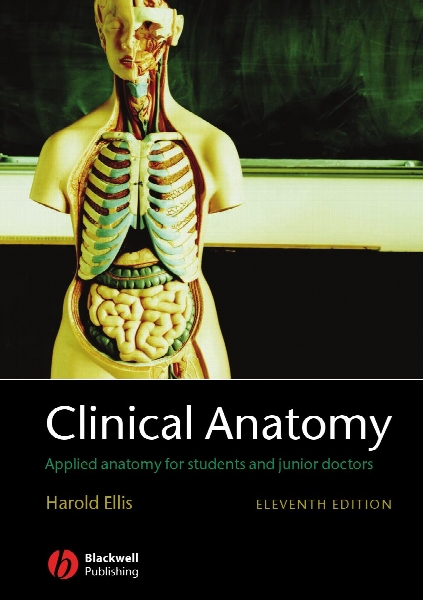Clinical anatomy : a revision and applied anatomy for clinical students
- نوع فایل : کتاب
- زبان : انگلیسی
- مؤلف : Harold Ellis
- ناشر : Oxford : Blackwell Science
- چاپ و سال / کشور: 2006
- شابک / ISBN : 9781405138048.
Description
Part 1: The Thorax.Surface anatomy and surface markings.Surface markings of the more important thoracic contents.The thoracic cage.The thoracic vertebrae.The ribs.The costal cartilages.The sternum.The intercostal spaces.The diaphragm.The pleurae.The lower respiratory tract.The trachea.The bronchi.The lungs.The mediastinum.The pericardium.The heart.The superior mediastinum.The oesophagus.The thoracic duct.The thoracic sympathetic trunk.On the examination of a chest radiograph.Radiographic appearance of the heart.Part 2: The Abdomen and Pelvis.Surface anatomy and surface markings.Vertebral levels.Surface markings.The fasciae and muscles of the abdominal wall.Fasciae of the abdominal wall.The muscles of the anterior abdominal wall.The anatomy of abdominal incisions.The inguinal canal.Peritoneal cavity.Intraperitoneal fossae.The subphrenic spaces.The gastrointestinal tract.The stomach.The duodenum.Small intestine.Large intestine.The appendix.The rectum.Arterial supply of the intestine.The portal system of veins.Lymph drainage of the intestine.The structure of the alimentary canal.The development of the intestine and its congenital abnormalities.The gastrointestinal adnexae: liver, gall-bladder and its ducts, pancreas and spleen.The liver.The biliary system.The gall-bladder.The pancreas.The spleen.The urinary tract.The kidneys.The ureter.The embryology and congenital abnormalities of the kidney and ureter.The bladder.The urethra.The male genital organs.The prostate.The scrotum.Testis and epididymis.Vas deferens (ductus deferens).The seminal vesicles.The bony and ligamentous pelvis.The os innominatum.The sacrum.The coccyx.The functions of the pelvis.Joints and ligamentous connections of the pelvis.Differences between the male and female pelvis.Obstetrical pelvic measurements.Variations of the pelvic shape.The muscles of the pelvic floor and perineum.The anterior (urogenital) perineum.The posterior (anal) perineum.The female genital organs.The vulva.The vagina.The uterus.The Fallopian tubes.The ovary.The endopelvic fascia and the pelvic ligaments.Vaginal examination.Embryology of the Fallopian tubes, uterus and vagina.The posterior abdominal wall.The suprarenal glands.Abdominal aorta.Inferior vena cava.Lumbar sympathetic chain.Part 3: The Upper Limb.The female breast.Structure.Blood supply.Lymphatic drainage.Development.Surface anatomy and surface markings of the upper limb.Bones and joints.Muscles and tendons.Vessels.Nerves.The bones and joints of the upper limb.The scapula.The clavicle.The humerus.The radius and ulna.The bones of the hand.The shoulder.The elbow joints.The wrist joint.The joints of the hand.The arteries of the upper limb.The axillary artery.The brachial artery.The radial artery.The ulnar artery.The brachial plexus.The segmental cutaneous supply of the upper limb.The course and distribution of the principal nerves of the upper limb.The axillary nerve.The radial nerve.Branches.The musculocutaneous nerve.The ulnar nerve.The median nerve.The anatomy of upper limb deformities.The spaces of the hand.The superficial pulp space of the fingers.The ulnar and radial bursae and the synovial tendon sheaths of the fingers.Part 4: The Lower Limb.The anatomy and surface markings of the lower limb.Bones and joints.Bursae of the lower limb.Mensuration in the lower limb.Muscles and tendons.Vessels.Nerves.The bones and joints of the lower limb.The os innominatum.The femur.The patella.The tibia.The fibula.A note on growing ends and nutrient foramina in the long bones.The bones of the foot.The hip.The knee joint.The tibiofibular joints.The ankle.The joints of the foot.The arches of the foot.The anatomy of walking.Three important zones of the lower limb-the femoral triangle, adductor canal and popliteal fossa.The femoral triangle.The fascia lata.The femoral sheath and femoral canal.Femoral hernia.The lymph nodes of the groin and the lymphatic drainage of the lower limb.The adductor canal (of Hunter) or subsartorial canal.The popliteal fossa.The arteries of the lower limb.Femoral artery.Popliteal artery.Posterior tibial artery.Anterior tibial artery.The veins of the lower limb.Clinical features.The course and distribution of the principal nerves of the lower limb.The lumbar plexus.The sacral plexus.The sciatic nerve.The tibial nerve.The common peroneal (fibular) nerve.Segmental cutaneous supply of the lower limb.Part 5: The Head and Neck.The surface anatomy of the neck.The fascial compartments of the neck.The thyroid gland.The parathyroid glands.The palate.The development of the face, lips and palate with special reference to their congenital deformities.The tongue and floor of the mouth.The tongue.The floor of the mouth.The pharynx.The nasopharynx.The oropharynx.The palatine tonsils.The laryngopharynx.The mechanism of deglutition.The larynx.Blood supply.Lymph drainage.Nerve supply.The salivary glands.The parotid gland.The submandibular gland.The sublingual gland.The major arteries of the head and neck.The common carotid arteries.The external carotid artery.The internal carotid artery.The subclavian arteries.The veins of the head and neck.The cerebral venous system.The venous sinuses of the dura.The internal jugular vein.The subclavian vein.The lymph nodes of the neck.The cervical sympathetic trunk.The branchial system and its derivatives.Branchial cyst and fistula.The surface anatomy and surface markings of the head.The scalp.The skull.Development.The accessory nasal sinuses.The frontal sinuses.The maxillary sinus (antrum of Highmore).The ethmoid sinuses.The sphenoid sinuses.The mandible.The temporomandibular joint.The teeth.The vertebral column.The cervical vertebrae.The thoracic vertebrae.The lumbar vertebrae.The sacrum.The coccyx.The intervertebral joints.Part 6: The Central Nervous System.The spinal cord.Age differences.Structure.Descending tracts.Ascending tracts.The membranes of the cord (the meninges).The brain.The medulla.The pons.The cerebellum.The midbrain.The diencephalon.The hypothalamus.The pituitary gland (hypophysis cerebri).The thalamus.The cerebral hemispheres.The cerebral cortex.The insula.The connections of the cerebral cortex.The basal ganglia.The long ascending and descending pathways.The membranes of the brain (the meninges).The ventricular system and the cerebrospinal fluid circulation.The cranial nerves.The olfactory nerve (I).The optic nerve (II) and the visual pathway.The oculomotor nerve (III).The trochlear nerve (IV).The trigeminal nerves (V).The abducent nerve (VI).The facial nerve (VII).The auditory (vestibulocochlear) nerve (VIII).The glossopharyngeal nerve (IX).The vagus nerve (X).The accessory nerve (XI).The hypoglossal nerve (XII).The special senses.The nose.The ear.The eye and associated structures.The autonomic nervous system.Visceral afferents.The sympathetic system.The sympathetic trunk.The parasympathetic system.Glossary of eponyms.Index
Fully updated with more CT scans for diagnostic illustration, this comprehensive text provides up-to-date information on clinical anatomy


